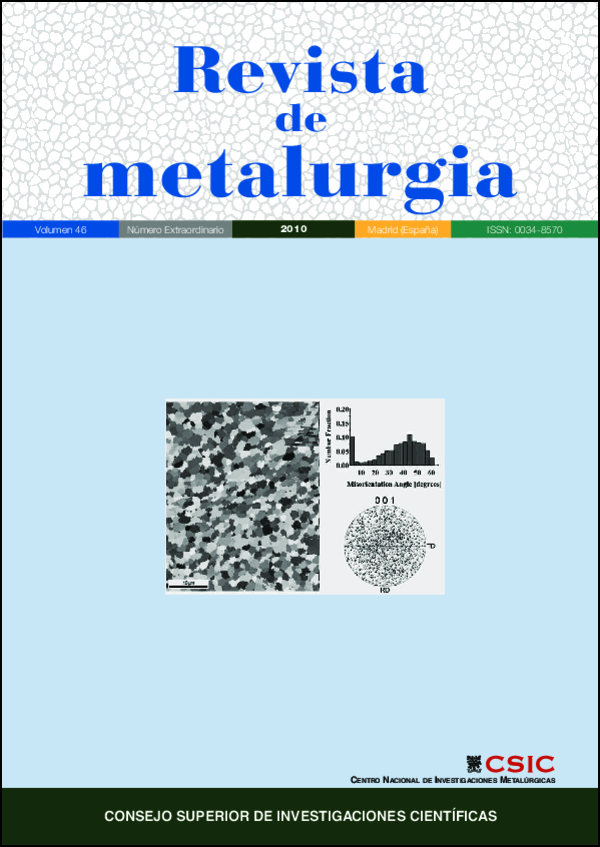Optimized methodology for the wear simulation of metallic materials
DOI:
https://doi.org/10.3989/revmetalmadrid.11XIIPMSKeywords:
Wear, Finite element, Variable speed factor, Metallic materials, Optimized methodologyAbstract
The wear simulation with finite element method (FEM) presents great advantages for the improvement of components, because of the reduction in the cost in comparison to the experimental procedure (test time, materials, tribological measurements). In the case of wire rope optimization, where one of the great problems is wear due to fretting in cylinder-cylinder contact points, this method could be efficient. Nevertheless, the wear simulation results in a complex methodology: on the one hand is needed to solve the contact problem and on the other hand the introduction of the wear model. For this reason, this methodology results in high computational time consuming. Consequently an efficient methodology for the optimization of the model, in terms of the reduction of computational time, is presented in this work for a block-on-ring system. Finally a variable wear speed factor and auto-fitting with respect to the evolution of maximum contact pressure and with respect to the maximum limit wear increment is introduced. This is necessary, in systems where high amount of wear is presented with a reduction of 87 % in computational time and an error of less than 1 %.
Downloads
References
[1] M.A. Urchegui,W. Tato y X. Gómez, J.Mater. Eng. Perform. 17 (2007) 550–560. doi:10.1007/s11665-007-9165-5
[2] P. Podra y S. Andersson, Tribol. Int. 32 (1999) 71-81. doi:10.1016/S0301-679X(99)00012-2
[3] V. Hegadekatte, N. Huber y O. Kraft,Modelling. Simul. Mater. Sci. Eng. 13 (2005) 57-75. [4] N.H. Kim, D. Won, D. Burris, B. Holtkamp, G.R. Gessel, P. Swanson yW.G. Sawyer,Wear 25 (2005) 1.787-1.793.
[5] M. Oqvist, Wear 249 (2001) 6-11. doi:10.1016/S0043-1648(00)00548-2
[6] I.R. McColl, J. Ding y S.B. Leen, Wear 256 (2004) 1.114-1.1127.
[7] S. Fouvry, C. Paulin y C. Meunier, Wear 264 (2008) 26-36. doi:10.1016/j.wear.2007.01.037
[8] J. Ding, I.R. McColl y S.B. Leen, Wear 262 (2007) 1.205-1.216.
[9] R. Hernández, M. Riera y J.M. Prado, Reunión de usuarios de Abaqus, Madrid, 2006, http://www.principia.es/abaqus/usuarios_archivo.htm (obtenida 25.02.2011).
[10] V. Hegadekatte, S. Kurzenhäuser, N. Huber, O. Kraft, Tribol. Int. 41 (2008) 1.020-1.031.
[11] J. Ding, S.B. Leen, E.J.Willians y P.H. Shipway, Tribol. Mater. Surf. Interf. 2 (2008) 10-24. 0
[12] A. Cruzado, M. Hartelt, R. Wäsche, M.A. Urchegui y X. Gómez,Wear 268 (2010) 1.409- 1.416.
[13] S. Fouvry, T. Liskiewicz y C. Paulin, Wear 263 (2007) 518-531. doi:10.1016/j.wear.2007.01.072
[14] J. Ding, Thesis, University of Nothingan, 2008.
Downloads
Published
How to Cite
Issue
Section
License
Copyright (c) 2010 Consejo Superior de Investigaciones Científicas (CSIC)

This work is licensed under a Creative Commons Attribution 4.0 International License.
© CSIC. Manuscripts published in both the printed and online versions of this Journal are the property of Consejo Superior de Investigaciones Científicas, and quoting this source is a requirement for any partial or full reproduction.
All contents of this electronic edition, except where otherwise noted, are distributed under a “Creative Commons Attribution 4.0 International” (CC BY 4.0) License. You may read the basic information and the legal text of the license. The indication of the CC BY 4.0 License must be expressly stated in this way when necessary.
Self-archiving in repositories, personal webpages or similar, of any version other than the published by the Editor, is not allowed.
















